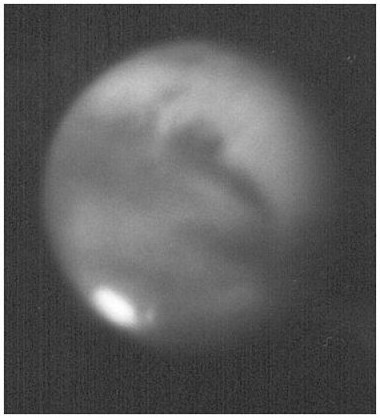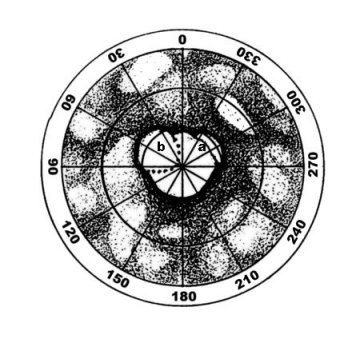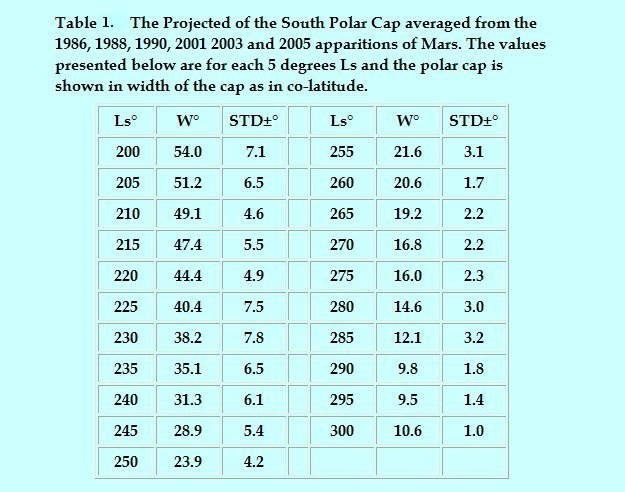
As the Martian South Pole emerges from the darkness of winter at the time of southern Spring Equinox, the dull-gray polar hood begins to retreat pole-ward and revealing the brilliant white edge of the cap (SPC). For decades planetary scientists held the belief that the SPC the composition of the Carbon Dioxide (CO2) ice with traces of water (H2O) ice. Recent studies by Caltech planetary science professor Andy Ingersoll and his graduate student, Shane Byrne, concluded that the decades old model of Mars’ polar caps being made of dry ice (frozen carbon dioxide) is in error [Ingersoll et al, 2003] [Rayl, 2003] [Titus et al, 2003].
Once free from the polar hood and exposed to direct sunlight, it sublimates rapidly, shines brilliantly, and undergoes spectacular changes during the rapid phase of spring thaw. We have studied the retreating or shrinking of the Martian polar caps for hundreds of years, however, observations of the initial formation of the south polar cap (SPC) are rare [Miyamoto, 1971]. Debate as to when the SPC forms has had little data to go on until the modern space craft began mapping the surface of the Red Planet on a daily basis. Some researchers suggested that the surface materials of the SPC form after the hood begins do dissipate on or about 176° Ls or right after the Vernal equinox (180° Ls) [Miyamoto, 1974].
During Perihelic apparitions the prominent south polar cap may be studied and measured to watch the edge of the cap retreat southward during late spring and summer, and in some cases see it reform during the late autumn or early winter. The South Polar Region (SPR) will tilt towards the Earth during these close apparitions and will remain so for a long time period. Some Mars apparitions that we refer to as “transitional” both caps will be studied for a good portion of the apparition.
Except for the effect of the terminator on the polar cap it will be in sunlight until opposition and because the Sub-Solar Point (Ds) will then begin to move northward, or more positive, with repeat to the Sub-Earth Point or the Areocentric declination of Earth (De). After that the south pole will be in the shadow of the southern portion of the limb terminator.

There is considerable difference in the north and south polar caps of Mars caused by the asymmetry in Martian seasons. The south cap is formed during the long, 382 (terrestrial) days of southern fall and winter when Mars is near aphelion, and it covers more than 70º areocentric degrees at greatest extent (extending below latitude 55º). The north cap is formed during the short, warmer 305 (terrestrial) days of northern fall and winter when Mars is near perihelion, and it usually measures only about 53º at maximum extent (Slipher, 1962) (Michaux, 1972).Figure 1. Photograph of Mars with south polar region tilted towards Earth and "Life Saver Effect" to center of south polar cap hood (211° Ls). Photo by C.F. Capen, Lowell Observatory 24-inch Clark, ID # 710707CI1142
MARTIAN SOUTH POLAR CAP PERIPHERY
Upon emergence from beneath the polar hood, the SPC appears to have a rather smooth and uniform border. Later, during the rapid thaw period, the edge of the cap will appear uneven. Several bright, white projections will begin to detach from the SPC around this time (210° Ls) and a number of dark rifts in the SPC will become apparent. One of the first of these rifts should be the Magna Depressio (270° W, 80° S).
Near 215° Ls, a dark rift, Rima Australis should appear between 290° W and 350° W, connecting with Magna Depressio. Also, the SPC develops a bright projection from 010° W to 020° W in Argenteus Mons. From 220° Ls, a bright projection, Novissima Thyle, develops at 300° W to 330° W, and a dark rift, Rima Angusta, appears at 60° W to 300° W (See Figure 2).

The Novissima Thyle is the famous recurrent cap remnant located south of Hellas, known as the "Mountains of Mitchel," discovered in 1845 by O.M. Mitchel, at the Cincinnati Observatory, Ohio. Once Novissima Thyle becomes detached from the cap edge it is known as Novus Mons ("New Mountains") and will form two small white patches near the south polar cap edge. This rift will be particularly prominent during the first two weeks of July (213° - 221° Ls). Located near 300° - 330° W and 75° S, this pair of brilliant white dots can be detected with 8-inch apertures or smaller (See Figure 3).Figure 2. An orthographic south polar projection reference map of the Martian south polar feature locations and names. Drafted by C.F. Capen.

Figure 3. Photograph of Mars with south polar region tilted towards Earth and "Mountains of Mitchel" to the left of polar cap. Photo by C.F. Capen, Lowell Obs. 24-inch, ID # M880827R1307.
During early May, 2005 look for the SPC will
be rapidly shrinking, and its brilliant whiteness will contrast
with its dark rifts, making the South Cap the most salient and
beautiful feature on the Martian globe. Novus Mons to
become detached from the cap edge during the first week in July
at about 217° - 220° Ls, and to disappear in sometime in late
August or early September (250 °- 260° Ls).

Figure 4. The Martian South Polar Region during early southern summer (270° – 280° Ls). Two large ice deposits make up the mail polar cap separated by a dark rift (a), Rima Australius, and a dotted line (b) that indicates the last remnant of the south polar cap in 1986 during southern mid-summer (320° - 340° Ls). The polar cap is offset from the true pole by several degrees latitude in the direction of Areocentric longitude 35° to 40°.
Figure 5. Retreat of the South Polar Cap (SPC) averaged from the 1986, 1988, 1990, 2001, 2003 and 2005 apparitions of Mars. Black line represents the average width in degrees of the SPC. Green and red lines represent the standard deviation from the average. Ls is the longitude of the Sun.

Using color filters, orange (W23A), yellow (W15), and green (W57), the observer enhances the contrast of the brilliant cap and projections. The brilliant white polar caps of Mars are among the planet’s most prominent and intriguing features. Because the Martian polar caps are affected by the 25.2° axial tilt of the planet [Kieffer et al, 1992], they are observed to thaw and re-accumulate in an annual seasonal cycle. Indeed, many of the observed surface changes and atmospheric phenomena appear to be directly coupled to the seasonal climate which causes the spring thawing phase of one polar cap as autumn allows the reformation phase of the opposite cap.
Planetary scientists have shown the white substance of the Martian polar caps is probably some form of crystallized water or solidified volcanic carbon dioxide. Space mission data sent back from Mars confirmed Earth-based observations of frozen water and carbon dioxide in the Martian polar caps. Sublimation of the H2O and CO2 contributes to the Martian atmospheric clouds and hazes as the spring and summer cap-thaw becomes more rapid.
Many interesting cloud or ice-fog formations appear at the polar regions of Mars during late spring as the sub-solar point rises higher in the Martian latitudes. Since the atmospheric pressure is usually below the point that water can become liquid and temperatures are usually below the freezing point, especially in the polar regions, melting of the polar ice is not possible. The sublimation process is responsible for the water vapors we find in the Martian atmosphere that forms hazes and clouds.
The dark banding that can often be seen surrounding the polar caps during retreat is thought to be caused by formations of hoarfrost at the edge of the polar cap. This rough or textured material lowers the reflection of Sunlight from that area of the surface and could possibly darken the surface adjacent to the polar cap. Recently some observers referred to this dark band at the SPC as the so-called "Lowell Bands." This feature was first associated with the north polar region (NPR) of Mars; however, to a lesser extent this can be seen in the south polar region. Any suggestion that damp, melted water ice from the polar cap causes this phenomenon is unfounded. In addition, from the perspective of Earth-bound observers the brilliant reflection from the polar cap next to a darker surface material will cause a "contrast effect," as we observers refer to it. When very bright objects are placed next to duller, material we tend to see a band separating the two darker than it really is. Irradiation in the human eye is another cause for this phenomenon.
Both polar regions exhibit similar behavior during their respective early-spring periods. Often, each emerges from its winter darkness when its dull-gray hood begins to dissipate as spring progresses, then its brilliant polar cap peeks out and begins to retreat pole-ward. This is especially true for the Northern Polar Region (NPR), however, observers have noted that occasionally when the Southern Polar Region (SPR) reaches the end of its respective winter season it is often clear of its dull cloud/haze canopy. This has led astronomers to considerable debate over the seasonal behavior of the SPR.
The south polar cap summer remnant is not centered on the polar axis but offset in latitude in the general direction of 35° to 40° longitude. If the central meridian (CM) is at 60° then the polar cap is fully visible and off set towards the observer. The polar cap can apparently disappear at times, especially when Mars is at 240° CM if any part of the terminator is present at the south pole of Mars. Figure 6 illustrates the position of the south pole when centered toward or away from the observer, and with to the extreme left or right of the 60° CM.

Figure 6. The south polar cap of Mars is not centered on the polar axis but offset in latitude in the general direction of 35° to 40° longitude. The four images, left to right, illustrate the central meridian of Mars at 330°, 60°, 150° and 240°. The position of the polar cap is apparently centered on Mars’ south pole at 60°.
REFERENCES
Ingersoll, Andy and Shane Byrne (2003), “The Martian polar caps are almost entirely water ice, Caltech research shows,“ Caltech Media Press Release, PR12342, http://pr.caltech.edu/media/Press_Releases/PR12342.html
Kieffer, H.H., B. M. Jakosky, C.W. Snyder, and M.S. Matthews, Editors (1992), Chapter 9, “Long-Term Orbital and Spin Dynamics,” Mars, University of Arizona Press, pp.304-305
Michaux, C.M. and Newburn, R.L.,( 1972). "Mars Scientific Model", JPL Document No. 606-1, “Seasonal Activity,” Section 4.2, p.3.
Miyamoto, S., (1971), “Observed Seasonal Change of the Southern Martian Polar Cap,” Astronomy and Space, 227-231.
Miyamoto, S., (1972), “Life Cycle of Martian Polar Cap, Sand Storm and General Circulation,” Contrib. Kwasan Hida Obsevatories, 207, 73-75.
Miyamoto, S., (1974), “Seasonal Change of the Martian Polar Caps,” Contrib. Kwasan Hida Obsevatories, 218, 1-8.
Rayl, A.J.S., (2003), “Researchers
Find Mars’ South Pole Cap is Mostly Water Ice,”
Planetary Society News,
http://www.planetary.org/html/news/articlearchive/headlines/2003/mars_s-pole_water-ice.html
Slipher, E. C., 1962, Mars,
the photographic story: Cambridge, Mass., Sky Publishing
Corp., and Flagstaff, Ariz., Northland Press, 168 p.
1, 1972
Titus et al., (20030, “Exposed Water Ice Discovered near the South Pole of Mars,” Science 299: 1048-1051